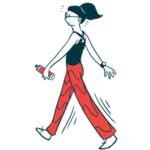Ekso’s Wearable Exoskeleton Cleared by FDA for Walking Rehab Use

The U.S. Food and Drug Administration has given Ekso Bionics clearance to market its wearable robotic exoskeleton to aid in rehabilitation programs to improve gait and mobility in people with multiple sclerosis (MS).
Dubbed EksoNR, the device had been approved by the regulatory agency for stroke and spinal cord injury patients in 2016 and those with acquired brain injury in 2020. Now, it is the first of its kind to be cleared for rehabilitative use in MS, Ekso reported.
“As a leader in early-to-market wearable robotic solutions for medical rehabilitation, we are committed to maximizing patient access to our technology,” Steven Sherman, chairman and CEO of Ekso, said in a press release.
“With the indications for use now expanded to include MS, the EksoNR has the potential to assist significantly more patients and improve patient mobility. We are excited to see the device benefit MS patients, providing critically needed rehabilitation solutions just as it has for patients [with] stroke, spinal cord injury and acquired brain injury,” Sherman added.
Gait and balance problems are among the most common symptoms of MS, which can significantly affect a person’s ability to walk independently. Physical rehabilitation, particularly programs targeting walking skills, are aimed to help patients improve their mobility.
But severe walking difficulties can hinder a person’s ability to participate in these rehabilitative therapies. The use of robotic devices during gait training are thought to be one way of maximizing rehabilitation gains in these patients.
EksoNR, a next-generation version of the Ekso GT device, is worn over a patient’s clothing and fitted to their body during physical rehabilitation. It has specialized sensors and motors that manipulate a person’s legs and waist to assist them while they practice standing, walking, and sitting. EksoNR’s goal is to enable individuals with limited standing and walking ability to perform these movements during therapy.
A number of studies have demonstrated the therapeutic potential of Ekso’s device.
A pilot study (NCT04000373), sponsored by the Cleveland Clinic, evaluated the safety and feasibility of Ekso GT during rehabilitation training in five people with MS and moderate or severely limited mobility. All underwent three weekly sessions consisting of stretching and gait training with the device for eight weeks.
Participants were generally satisfied with the device, reporting scores ranging from 3.4 to 4.8 out of five on the Quebec User Evaluation of Satisfaction with Assistive Technology, version 2 (QUEST 2.0), with higher scores reflecting greater satisfaction. Improvements in gait speed and step height were also seen after training, the Cleveland Clinic reported.
Eight adverse events, including pain, skin abrasions, or falls between training sessions were reported in four participants, all of which were mild or reversible.
Another pilot study, published by Kessler Institute researchers last year, showed that four weeks of exercise rehabilitation using the Ekso GT device worked better than conventional gait training at improving mobility and cognitive function in MS patients with substantial walking difficulties.
The Kessler Foundation is now sponsoring a trial (NCT04855825) to further investigate the effects of Ekso’s device on mobility, learning and memory, and walking ability compared with conventional gait therapy in adults with MS.
That trial is currently recruiting patients, ages 18 to 75, with any form of MS and moderate to severe walking difficulties at the foundation’s West Orange, New Jersey, site.
EKsoNR is also CE-marked — meaning it has met safety, health, and environmental protection requirements — and available in Europe.
“Used by more than 375 rehabilitation centers globally, Ekso devices have helped patients take nearly 200 million steps, while supporting patients’ hopes of mobility and independence,” the company said in the press release.







